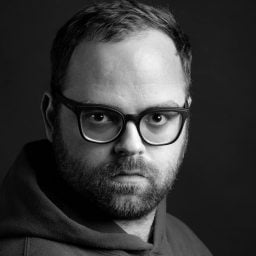Art & Exhibitions
At the Playful ‘KAWS + Warhol,’ Two Pop Art Titans Finally Meet
The show at the Andy Warhol Museum explores the artists' shared fascinations with sex, consumerism, and destruction.
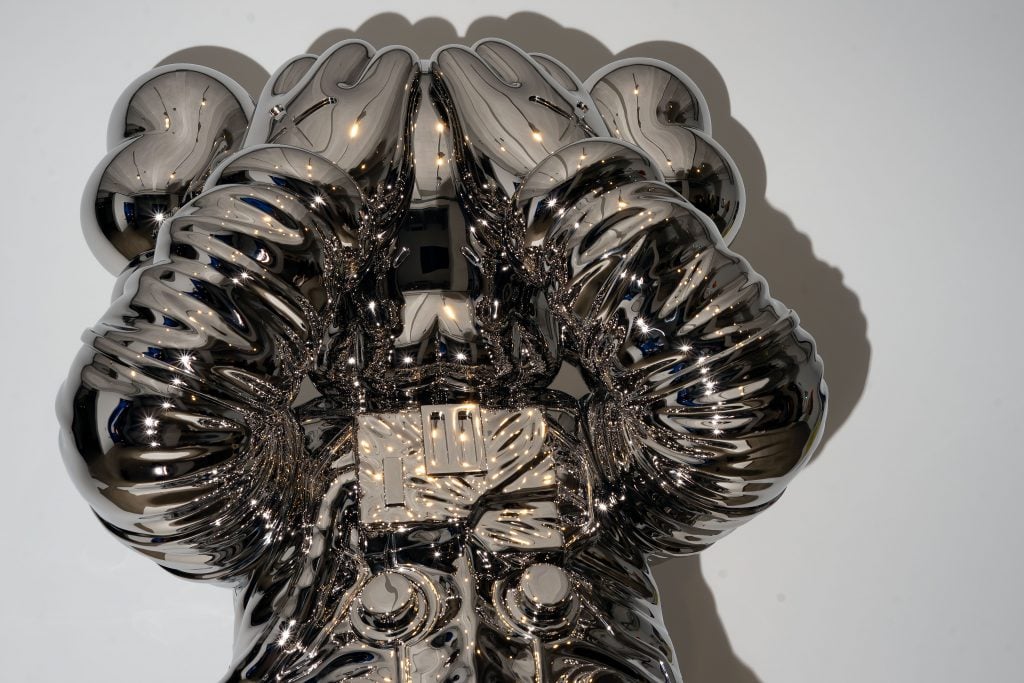
A new exhibition of work by Brian Donnelly, aka KAWS, at the Andy Warhol Museum in Pittsburgh puts the contemporary artist in conversation with his storied predecessor.
The show “KAWS + Warhol” opened May 17, in true Warholian spirit, with a star-studded guest list including Pusha T, shoe designer John Geiger, and graffiti legend Futura. It was envisioned by Patrick Moore, the museum’s outgoing director who curated the exhibition, when he noticed how KAWS’s 2021 show at Skarstedt Gallery in New York drew a large young crowd. Moore hoped to bring a similar spirit to the Warhol Museum, particularly on its 30th anniversary, while showcasing how the Pop artist’s legacy endures in the living likes of KAWS.
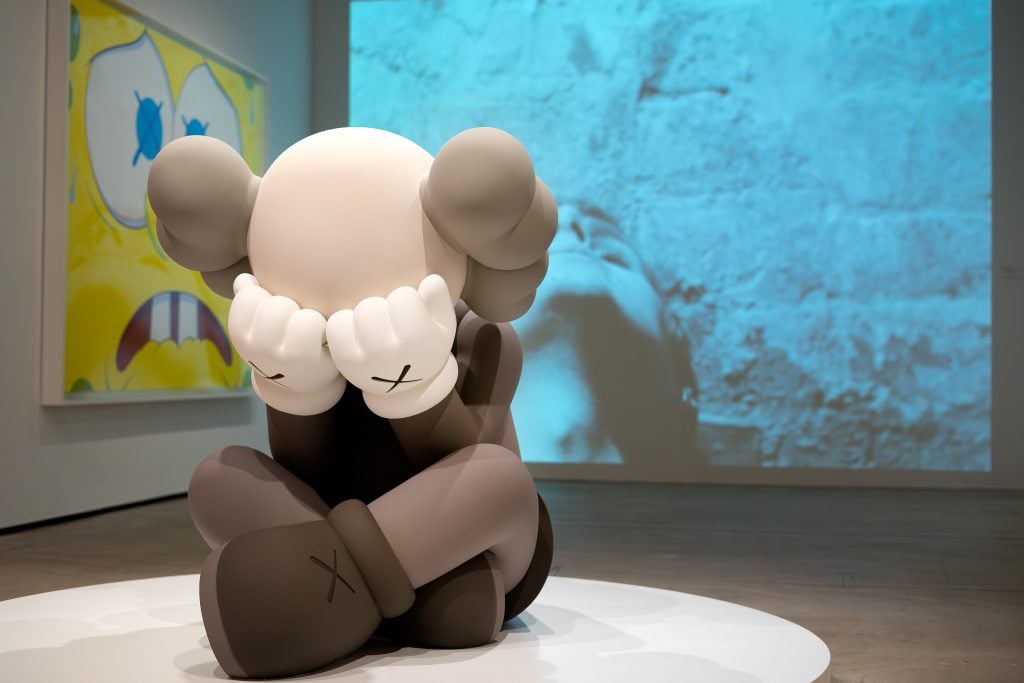
Installation view of “KAWS + Warhol” at the Andy Warhol Museum in Pittsburgh, Pennsylvania, 2024. Photo by Adam Schrader.
For example, a crowd favorite at the exhibition was the placement of the Warhol’s film Blow Job (1964) with two of KAWs’s KAWSBob paintings, the artist’s dark parody of the children’s cartoon character SpongeBob.
“I said to Brian, ‘Have you seen this film Blow Job.’ He’s like, ‘no.’ And I said, ‘let’s look at,’” Moore said. “If you know the title, you know what’s going on. [The subject of the film], at many points, throws his head back and it’s unclear: is he in pain? Is he having pleasure? And then we have Brian reinterpreting Sponge Bob as KAWSBob in the same way.”
To Moore, the similarities go on from there. He equates Warhol’s penchant for repetition and his cadre of Superstars with how KAWS treats his characters as motifs. He sees their shared fascinations with sex and destruction.
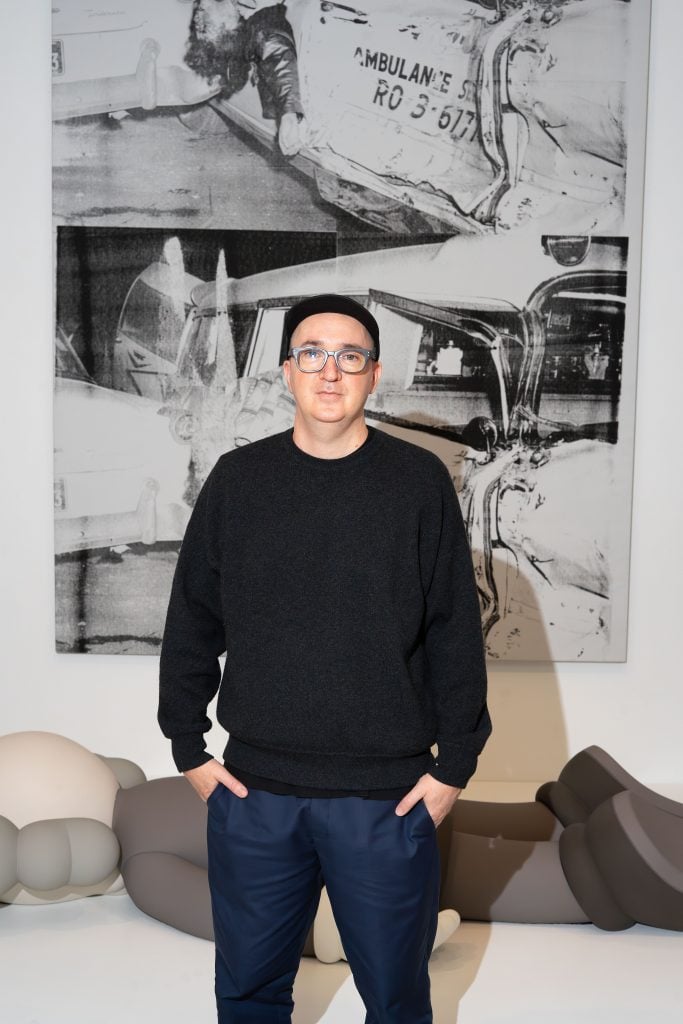
Brian Donnelly, aka KAWS, in front of his Companion 2020 and Andy Warhol’s Ambulance Disaster (1963) at the Andy Warhol Museum in Pittsburgh, Pennsylvania. Photo by Adam Schrader.
The exhibition’s Instagrammable centerpiece pairs Warhol’s Ambulance Disaster with KAWS’s Companion 2020. It was the first coupling Moore showed Donnelly when asking him to do the show. The Warhol work replicates a newspaper photograph of an ambulance in a crash using silkscreen ink on linen. KAWS’s sculpture is a painted bronze of a cartoon-like character lying face down. Moore loved how “they’re treating death in a very different way.”
Donnelly agreed with Moore’s assessment. “I just think there’s a sense of tragedy and seeing Companion 2020 alone might feel more about exhaustion or dealing with the state of the world that we’re in,” he said. “But having it in context with the ambulance crash, it feel like a much more tragic work.”
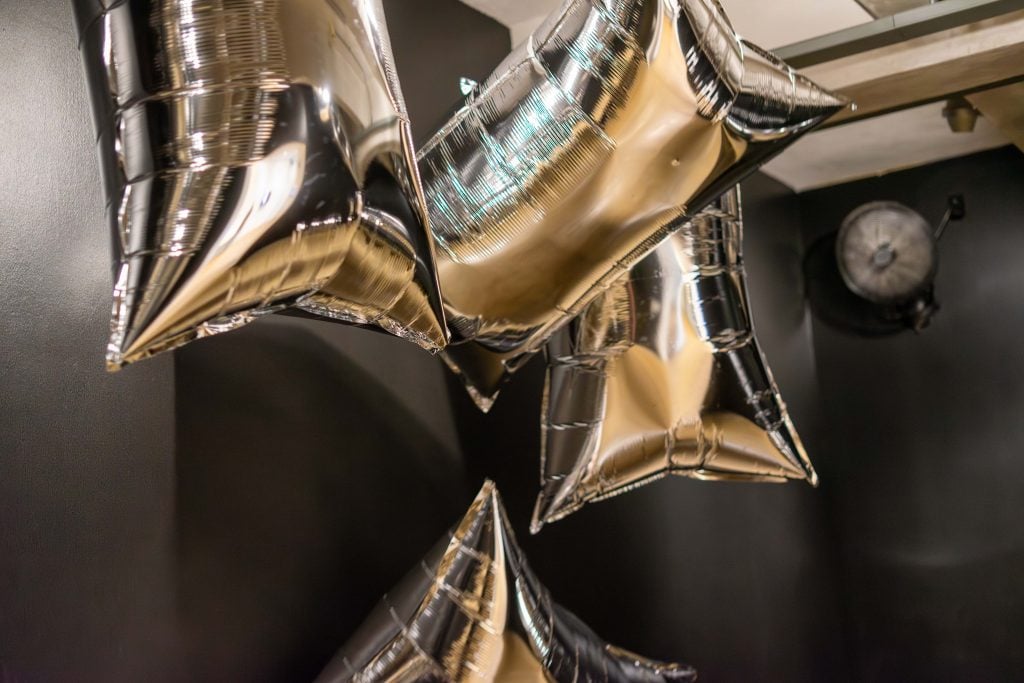
Andy Warhol, Silver Clouds (1966), on view at “KAWS + Warhol” at the Andy Warhol Museum in Pittsburgh, Pennsylvania, 2024. Photo by Adam Schrader.
At least one guest identified a missed opportunity to pair Warhol’s Silver Clouds—an installation of pillow-shaped silver balloons filled with helium—with KAWS’s Space, a silver-colored sculpture of one of his characters as an astronaut. And not everybody was immediately a fan.
Before the show opened, Donnelly said he was most looking forward to sharing his artwork in person with the people of Pittsburgh who might only be familiar with his work through online images. When we caught up with him after the show, Donnelly said the preview was a blur but remembered one woman admitting to him she “wasn’t always a fan” but warmed to him after seeing his works in person.
“The thing about Warhol: there’s so many bodies of work to delve into and there’s so much that’s not in the show, like we didn’t tap into any of the fashion overlapping with him,” Donnelly said. He expressed interest in doing a second show with Warhol to dive into further comparisons.
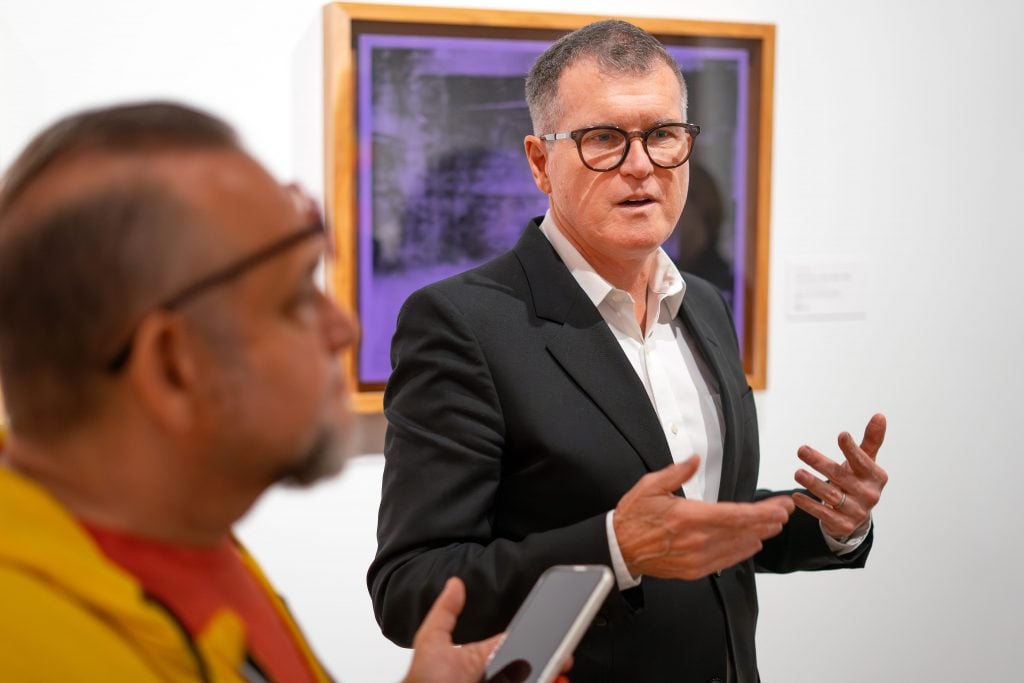
Warhol Museum director Patrick Moore at the “KAWS + Warhol” exhibition at the museum. Photo by Adam Schrader.
The artist professed an enduring interest in Warhol’s work, especially because he “opened the door” for other Pop artists. He is especially inspired by Warhol’s work with fashion and his toy paintings—unsurprising for an artist for whom toys have long been a medium.
“I choose to work in those outlets because that’s how a lot of work reached me. And I constantly think about how my work could disseminate,” he said. “I love the connection I get to have through making objects and clothing. I don’t think it would be possible from me just making paintings, drawings, sculpture.”
Donnelly got his start on the streets of New York in the ’90s, his graffiti work paving the way for his paintings and sculptures that leaned into a similar cartoon-like aesthetic. From 1999, his characters—such as Chum, Companion, BFF, and Bendy—would also appear for sale as vinyl figurines, sparking off a still-thriving marketplace for the artist. Over his career, he has partnered with brands including Nike, Dior, Uniqlo, and Disney to create limited-edition products.
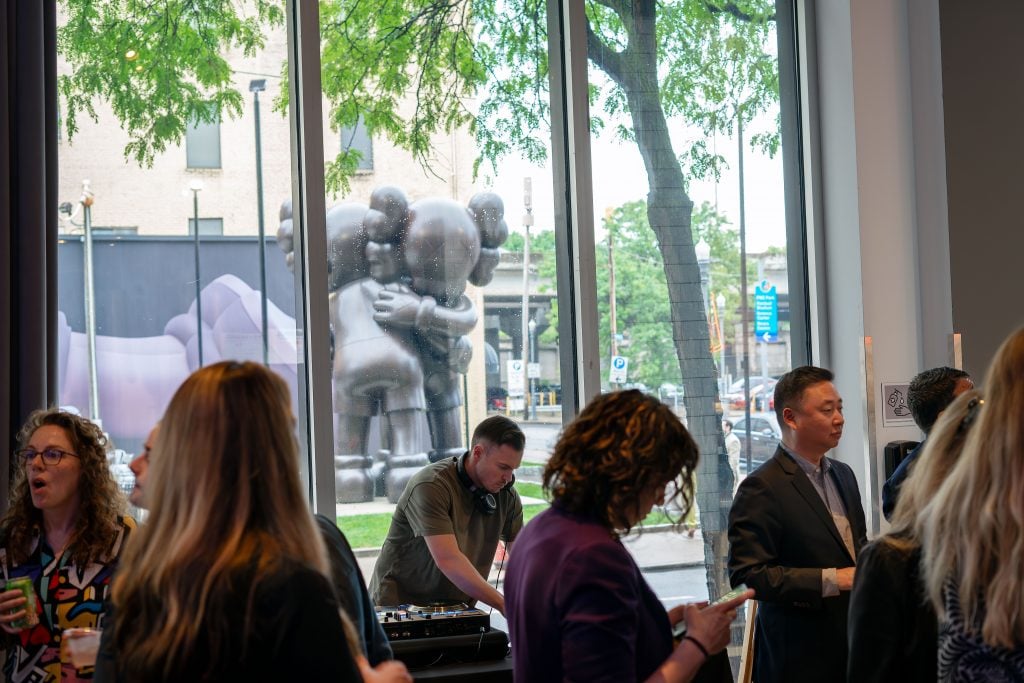
Preview of the “KAWS + Warhol” exhibition at the Andy Warhol Museum with a sculpture by KAWS seen installed outdoors. Photo by Adam Schrader.
KAWS’s cartoon-centric style and inspirations echo Warhol’s own fascination with consumer branding and advertising. In the show, Warhol’s Brillo boxes are staged before a wall of 2,000 cereal boxes KAWS made in collaboration with General Mills featuring beloved characters such as Count Chocula and FrankenBerry.
“It’s funny. I never really think about making work targeted for children at all,” said Donnelly, who has two children. “With General Mills, that’s just something I always loved—cereal box graphics, and especially the monsters, started around the time I was born. I wanted to make work that can be in bodegas and shopping centers and have it on the shelf with all the stuff I grew up on.”
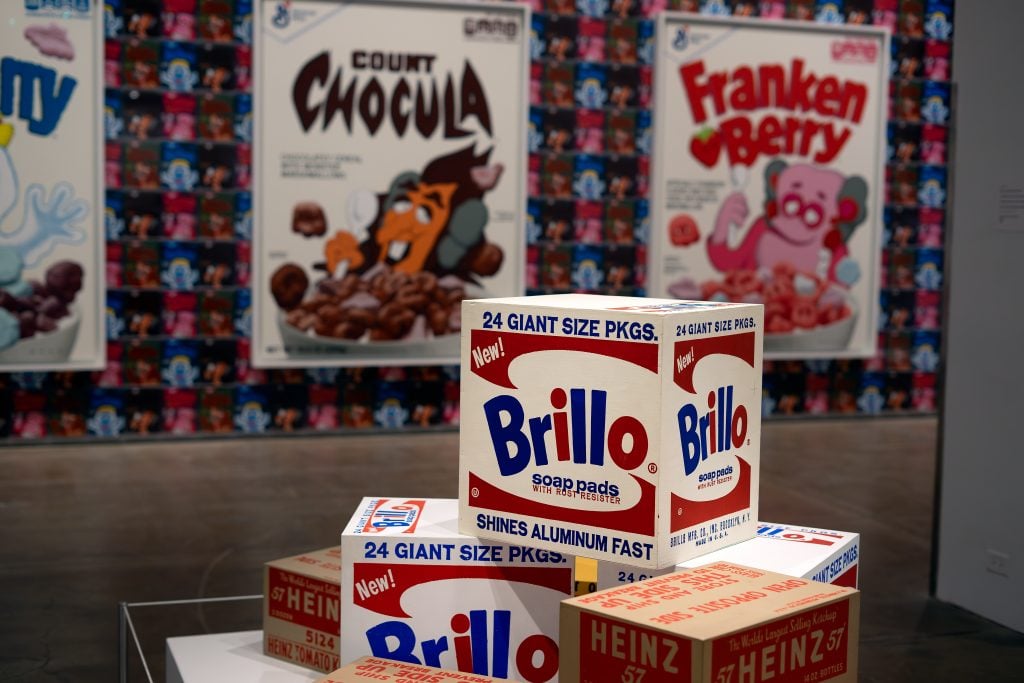
Installation view of “KAWS + Warhol” at the Andy Warhol Museum in Pittsburgh, Pennsylvania, 2024. Photo by Adam Schrader.
Interestingly, the sweetness of the breakfast food could even be smelled in the room with the cereal boxes, creating what could be described as an immersive experience. Still, Donnelly insisted: “I’m not trying to theme-park it”—an interesting comment when comparing KAWS, a one-time street artist, with the likes of Banksy, the world’s most beloved anonymous street artist, whose Dismaland theme park was direct criticism of consumerism.
Much like Warhol, Donnelly himself is not against consumerism and appreciates “making good things and putting it out in the world.” He also praised artists like Keith Haring that helped further break down such barriers.
“Even today it feels a bit taboo working within the commercial space and with larger companies, even though it’s way more accepted now than it was 10 years ago,” he said. “Keith opened the Pop Shop and put the line in the sand just said, ‘Listen, this is my interest whether you accept it or not. This is kind of the direction I’m going.’ And I always loved that about him.”
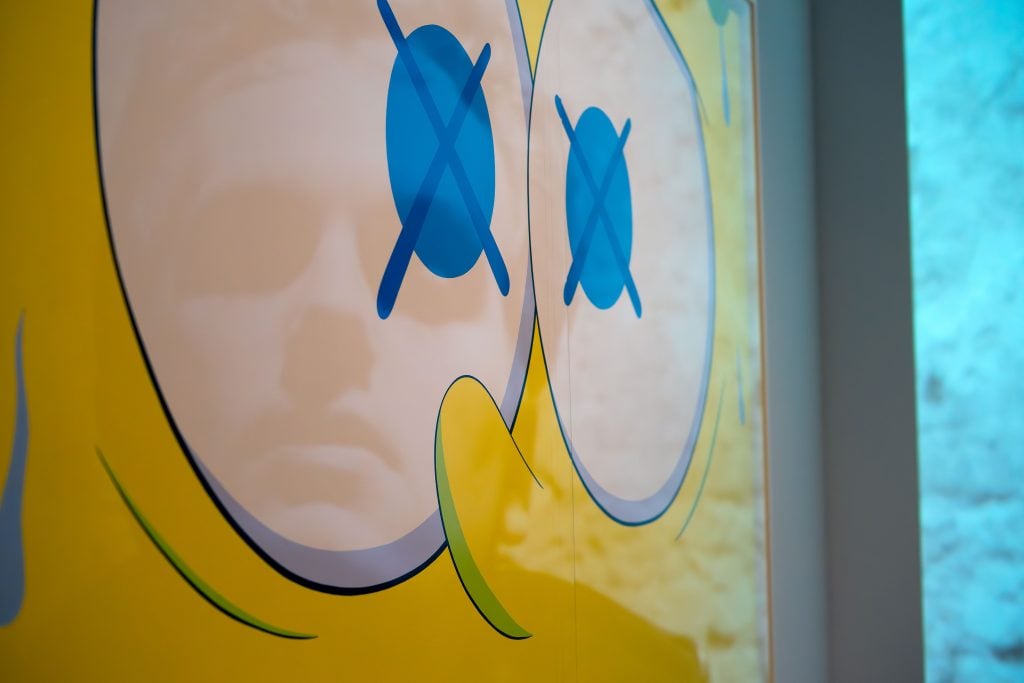
Andy Warhol’s Blow Job (1964) reflected in a KAWS canvas. Photo by Adam Schrader.
For centuries, since the likes of Albrecht Dürer, artists have been trying to spur the patron, the wealthy businessmen who funded their work. Now, artists like KAWS are turning to corporate partnerships.
“I would imagine that throughout history all artists had to think about how to be clever and get the work that they want made,” Donnelly said, when asked about the phenomenon. “And there’s tons of opportunities to make work and subsidize other works you need to get made.”
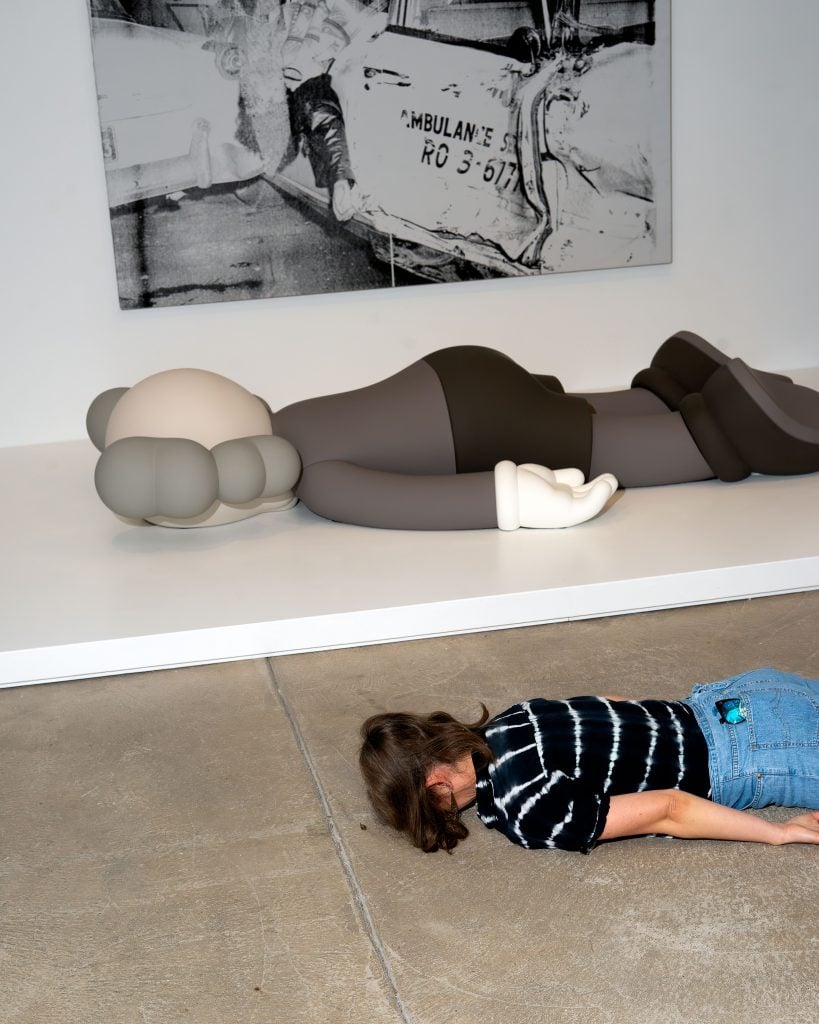
Installation view of “KAWS + Warhol” at the Andy Warhol Museum in Pittsburgh, Pennsylvania, 2024. Photo by Adam Schrader.
But when it came to creating merchandise for the show, KAWS went for a more reverent approach. Where he had once (illegally) painted his characters over Warhol’s Chanel No. 5 posters, he opted not to appropriate the Pop artist’s work this time, even with the Warhol Foundation’s blessing. His previous graffiti work, after all, was of an era “when I was just stealing stuff, painting over, and putting it out,” he said. Now, his art coexists with Warhol’s on the exhibition’s official merchandise, without one overstepping the other.
“It’s one thing to work with somebody who’s here that I could be in a room with and have an agreement,” he explained. “I just want to be really respectful of the work.”
“KAWS + Warhol” is on view at the Andy Warhol Museum, 117 Sandusky Street, Pittsburgh, Pennsylvania, through January 20, 2025.

